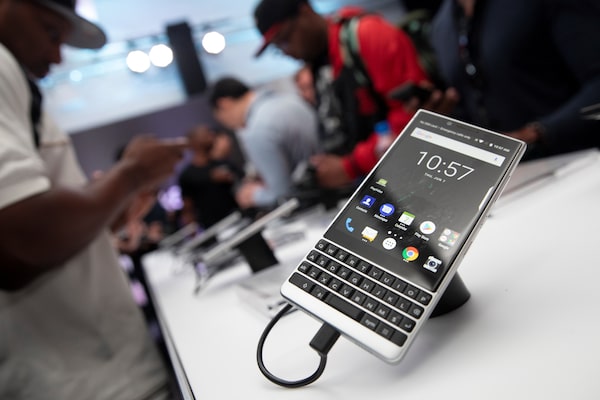
The last time BlackBerry's stock went this low, Jean Chrétien was prime minister.Mike Segar/Reuters
BlackBerry Ltd. stock hit a 16-year low on Tuesday, closing down for the sixth straight trading session amid concerns about the smartphone pioneer’s ability to deliver on a new strategy for growth.
The stock changed hands for as low as US$5.08 on the New York Stock Exchange before closing at US$5.15, down 1.9 per cent. The stock has declined 32 per cent since it reported disappointing second-quarter earnings last Tuesday, dragged down by poor results from its last legacy smartphone-related business. The stock last traded this low in September, 2003, when the Waterloo, Ont.-based company was just starting its big push to sell BlackBerry handsets to consumers, the iPhone didn’t exist and Jean Chrétien was prime minister.
In Toronto, BlackBerry shares closed at $6.79, down 15 cents or 2.2 per cent.
“This was going to be the year they started to grow [total] revenues by at least double digits,” CIBC analyst Todd Coupland, one of several analysts to slash his stock targets last week, said in an interview. “That hasn’t happened.”
The stock’s drop comes as BlackBerry tries to re-establish itself. When John Chen joined as CEO in 2013, BlackBerry was a smartphone company, albeit in decline. He tried unsuccessfully to revive the handset business while slashing costs and achieving positive cash flows. By this year the company was one-20th its peak size and device revenue hit zero.
But Mr. Chen had a story to sell. The company sells software that enables enterprises to manage their employee’s mobile devices, is a key supplier to the connected-car business through its fast-growing QNX software division, and recently purchased an artificial intelligence-based cybersecurity business called Cylance. By integrating those three, BlackBerry could offer a comprehensive “internet-of-things” platform that companies would use to securely manage a range of connected devices, from phones to cars to tractors. (The total market for its offerings is US$22-billion and growing fast, the company claims.)
BlackBerry also had a vast patent portfolio that it milked to generate licensing fees from other companies. “Given what he was handed I think he’s done a tremendous job of changing the entire face of the company and business model,” Macquarie analyst Maynard Um said in an interview.
To support his efforts, Mr. Chen asked chief technology officer Charles Eagan to create a lab to develop new technologies that would “get the various units to work together a little bit more,” Mr. Eagan said. “As the tsunami of connected devices wash ashore over the next five years, they all need to be managed … and the need to have a unified experience is becoming increasingly important."
But “investors need to see a stabilization of BlackBerry’s legacy business before they can even start caring about any of the new businesses that are growing,” Mr. Um said.
The legacy business Mr. Um refers to is BlackBerry’s last stronghold from its smartphone days: a software platform for enterprise users to centrally manage their employees’ mobile devices.
But that software business, known as unified endpoint management (UEM) is now a crowded, commoditized and mature sector with rivals that include Microsoft Corp., International Business Machines Corp. and MobileIron Inc. Meanwhile, BlackBerry’s UEM sales shrank for the third straight quarter, to less than US$60-million, Mr. Um said. (Total revenue of US$261-million in the quarter was below consensus analyst estimates.) Mr. Chen blamed the shortfall on an overhaul of the division’s sales force, estimating sluggishness would continue for two more quarters as the new sales team ramps up. “Although we are all disappointed with the short-term results … strategically we are in a very strong position” over all, Mr. Chen said last week.
But that division, which is supposed to generate the cash flow to invest in the QNX and Cylance businesses and “doesn’t look as stable as it needs to be for that to happen,” Mr. Coupland said.
The other issue is Cylance, which BlackBerry bought this year for US$1.4-billion. In the most recent quarter, Cylance’s non-GAAP revenue was US$51-million, unchanged from the preceding quarter, while rivals CrowdStrike Holdings Inc. and Carbon Black Inc. grew briskly. The prospect of slowing growth at Cylance also spooked investors, though Mr. Chen stood by his forecast of a 25-per-cent to 30-per-cent increase in its revenues this year.
BlackBerry is in a different place than it was in 2013. It doesn’t have a rival like Apple upending its core business. Its QNX platform is winning deals with car makers and praise from analysts as a contender to be a leading software player in the connected auto business. The company expects the addition of Cylance’s capabilities to its offerings next year to positively affect sales. “I call this a show-me story,” said Mr. Um. “The company needs to execute and we need to see a bottoming of the UEM business before investors have confidence.”
 Sean Silcoff
Sean Silcoff